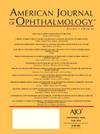Incidence and Prevalence of Syphilitic Uveitis and Associated Ocular Complications in the TriNetX Database
IF 4.1
1区 医学
Q1 OPHTHALMOLOGY
引用次数: 0
Abstract
Purpose
To determine the yearly and cumulative incidences and prevalences of syphilitic uveitis, concurrent sexually transmitted infections, and ocular complications using the United States TriNetX database.
Design
Trend study.
Participants
Subjects with syphilitic uveitis in the TriNetX database.
Methods
Subjects with syphilitic uveitis from 2013 to 2024 were identified with International Classification for Disease (ICD) codes for uveitis with the constraint of a positive treponemal and nontreponemal test for syphilis within 1 month after the diagnosis of uveitis. Incidence and prevalence data were calculated from 2013 to 2024. Additional data collected included demographics, concurrent infection with other sexually transmitted infections (STI- HIV, gonorrhea, chlamydia), and ocular complications (macular edema and low vision).
Main Outcome Measures
The primary outcomes were the incidence and prevalence of syphilitic uveitis (annual and cumulative). Secondary outcomes were the incidence and prevalence of concurrent sexually transmitted infections and ocular complications (annual and cumulative).
Results
From the 81 759 791 total population in TriNetx, 161 317 cases of syphilis and 237 cases of syphilitic uveitis were identified. Of the 237 patients with syphilitic uveitis, 53.58% (N = 127, 95% CI 47.2%-59.9%) were White and 75.10% (N = 178, 95% CI 69.6%-80.6%) were male, with a mean age of 52 years (Range: 20-90, SD = 15). The most common STI co-infection was HIV (32.49%, 95% CI 26.53%-38.45%, N = 77). The most prevalent ocular complication was low vision and blindness (27.85%, 95% CI 22.16%-33.54%, N = 66); of which, the highest rates of low vision and blindness were in the cohorts with pan or posterior uveitis (78.79%, N = 52). The cumulative incidence and prevalence rates of syphilitic uveitis over the 2013 to 2024 period were 0.36 and 0.27 cases per 100 000, respectively.
Conclusions
The rising incidence and prevalence of syphilitic uveitis from 2013 to 2024 mirrors the overall syphilis epidemic in the United States. This study highlights the need for serologic testing with treponemal and nontreponemal tests for syphilis in patients with uveitis and timely intervention to prevent irreversible visual complications.
TriNetX数据库中梅毒性葡萄膜炎及相关眼部并发症的发病率和患病率。
目的:利用美国TriNetX数据库确定每年和累积的梅毒性葡萄膜炎、并发性传播感染和眼部并发症的发病率和患病率。方法:2013-2024年患有梅毒性葡萄膜炎的受试者,在葡萄膜炎诊断后1个月内梅毒螺旋体和非螺旋体试验阳性的约束下,使用国际疾病分类(ICD)葡萄膜炎代码对其进行鉴定。2013-2024年的发病率和患病率数据。收集的其他数据包括人口统计、并发其他性传播感染(STI- HIV、淋病、衣原体)和眼部并发症(黄斑水肿和低视力)。主要结局指标:主要结局指标为梅毒性葡萄膜炎的发生率和患病率(年度和累积)。次要结局是并发性传播感染和眼部并发症的发生率和流行率(年度和累积)。结果:在TriNetx的81,759,791名总人口中,发现梅毒161,317例,梅毒葡萄膜炎237例。237例梅毒性葡萄膜炎患者中,53.58% (N= 127, 95% CI 47.2-59.9%)为白人,75.10% (N=178, 95% CI 69.6-80.6%)为男性,平均年龄52岁(范围:20-90岁,SD=15)。最常见的性传播感染合并感染为HIV (32.49%, 95% CI 26.53 ~ 38.45%, N=77)。最常见的眼部并发症是低视力和失明(27.85%,95% CI 22.16-33.54%, N=66);其中,低视力和失明发生率最高的是pan或后葡萄膜炎队列(78.79%,N=52)。2013-2024年梅毒性葡萄膜炎的累计发病率和患病率分别为0.36 / 10万和0.27 / 10万。结论:2013-2024年梅毒性葡萄膜炎的发病率和流行率上升反映了美国梅毒的总体流行情况。本研究强调了对葡萄膜炎患者进行梅毒螺旋体和非螺旋体血清学检测和及时干预以预防不可逆的视觉并发症的必要性。
本文章由计算机程序翻译,如有差异,请以英文原文为准。
求助全文
约1分钟内获得全文
求助全文
来源期刊
CiteScore
9.20
自引率
7.10%
发文量
406
审稿时长
36 days
期刊介绍:
The American Journal of Ophthalmology is a peer-reviewed, scientific publication that welcomes the submission of original, previously unpublished manuscripts directed to ophthalmologists and visual science specialists describing clinical investigations, clinical observations, and clinically relevant laboratory investigations. Published monthly since 1884, the full text of the American Journal of Ophthalmology and supplementary material are also presented online at www.AJO.com and on ScienceDirect.
The American Journal of Ophthalmology publishes Full-Length Articles, Perspectives, Editorials, Correspondences, Books Reports and Announcements. Brief Reports and Case Reports are no longer published. We recommend submitting Brief Reports and Case Reports to our companion publication, the American Journal of Ophthalmology Case Reports.
Manuscripts are accepted with the understanding that they have not been and will not be published elsewhere substantially in any format, and that there are no ethical problems with the content or data collection. Authors may be requested to produce the data upon which the manuscript is based and to answer expeditiously any questions about the manuscript or its authors.

 求助内容:
求助内容: 应助结果提醒方式:
应助结果提醒方式:


